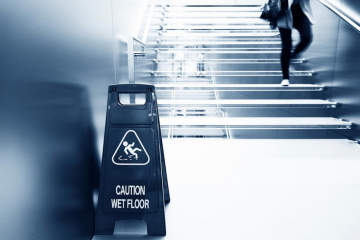Most technology companies are operating offices, call centers, and data centers around the world — lower-risk facilities with no boiling vats of chemicals or fast-moving parts that present extreme environment, health and safety (EHS) risks. But low risk certainly doesn’t mean no risk — and those risks can extend beyond the workplace.
“Just one high-visibility incident can have a disastrous ripple effect that can cause major PR headaches and damage a brand’s reputation,” Peylina Chu, Antea Group Vice President and Technology Segment Leader, says. “And in the highly-competitive tech sector, maintaining a strong brand is a business imperative — from retaining and recruiting top talent to keeping loyal customers.”
So, what steps can tech company EHS leaders take to proactively protect and bolster their brand? Below we offer reputation management tips and insights that can help you work brand building and protection into your overall EHS strategy.
1. Market EHS as an integral part of company culture
Most tech company EHS leaders know EHS success is rooted in company culture. As a result, many have focused on creating a culture of EHS, where employees feel they have the knowledge and encouragement to play an active role in program initiatives. However, most of the effort is focused on promoting EHS as a company value internally, leaving a greater marketing opportunity on the table.
Work with your marketing team to craft a plan for telling your EHS story to the world. Get started by integrating and promoting EHS initiatives across your company’s marketing channels (e.g. your website, company mission statement and handbook, print literature, social media, etc.). By marketing your commitment to a happy, healthy and safe workplace, you’ll be able to build and bolster your brand as one that puts your employees’ well-being first.
2. Monitor Social Media and third party review sites
Thanks to the work of many brilliant minds at tech companies, we live online these days. The internet and mobile technologies enable us to quickly learn, engage, connect, and make purchases — as well as air grievances. As a result, it's always reputation management best practice to monitor social media and third-party review sites. This helps you proactively address negative comments, as well as find opportunities to strengthen your brand.
But why should this be a priority for EHS teams? To put it simply, EHS-related issues crop up on these platforms. For example, company culture is an increasingly important decision-making factor for workers. As a result, review sites like Glassdoor are a go-to resource for understanding what it’s really like to work for a company — and negative feedback can turn prospective employees off, something tech companies can’t afford as they face a serious shortage of quality tech talent.
The bottom line? You know your team plays a leading role in creating great work environments, and monitoring social media and review sites allows you to unearth improvement opportunities. Furthermore, you’ll be able to address both positive and negative feedback head-on, show people you care and help minimize damage to your brand.
3. Engage key stakeholders
From C-suite executives to employees to customers, your organization has several key stakeholder groups that are impacted by your EHS initiatives — and they have the power to help shape and share your brand’s story.
Engage your stakeholders by inviting them to participate in developing and implementing your EHS initiatives to enhance the workplace and protect the environment. Invite your stakeholders to develop EHS metrics that are meaningful to THEM, and then report progress back to them using THEIR metrics. For example, employees may want to know about new initiatives or a team member going the extra mile to ensure EHS success. But an investor or the C-suite update is probably going to be more interested in how many customers are including EHS requirements in their RFPs and contracts, EHS incident data, and other details on how EHS is supporting overall business objectives.
In the end, these stakeholder engagement strategies provide stakeholders with information they can use to promote your commitment to EHS — and ultimately help strengthen your brand.
4. Implement an effective training program
There’s little doubt that regular training arms employees with the knowledge they need to drive the foundation of EHS — compliance. But regulations, policies and technology, as well as a company’s asset portfolio and workforces, can change at a rapid pace — which means training isn’t a one-time event.
But managing compliance from a distance is a top EHS challenge in the tech sector, according to EHS and sustainability leaders who attended our April 2017 EHSxTech event. So how can EHS teams ensure ongoing and effective training is happening?
Consider investing in a tool such as EHSInsight that allows you to track training at the facility, department and employee level. This will allow you to easily manage training across your facilities, allowing you to implement relevant trainings as policies and regulations change. You can also partner with an EHS consultant to develop customized training programs that integrate adult learning tools for truly effective training. And analyzing inspection and audit data can reveal trends where current training is ineffective or a training gap exists.
5. Craft an emergency action plan
Despite your best efforts, “newsworthy” incidents happen — and when they do, you need to be ready to respond with empathy and key messages that show your commitment to the environment, health and safety.
Work with your marketing or public relations department to craft an action plan that maps responsibilities and outlines key messages for possible incident scenarios (i.e. fatal accidents, chemical spills by a contractor, noncompliance, etc.). This will help you respond quickly and stay on message.
Play a Meaningful Role in Building & Protecting Your Brand’s Reputation
As EHS becomes more intertwined with business operations, EHS teams can make meaningful contributions to building and protecting their organization’s brand. Use these tips to help your efforts along.
Learn how an EHS audit and risk assessment from our EHS consulting firm can help evaluate and mitigate organizational, programmatic and operational vulnerabilities.
Want more news and insights like this?
Sign up for our monthly e-newsletter, The New Leaf. Our goal is to keep you updated, educated and even a bit entertained as it relates to all things EHS and sustainability.
Get e-NewsletterHave any questions?
Contact us to discuss your environment, health, safety and sustainability needs today.





